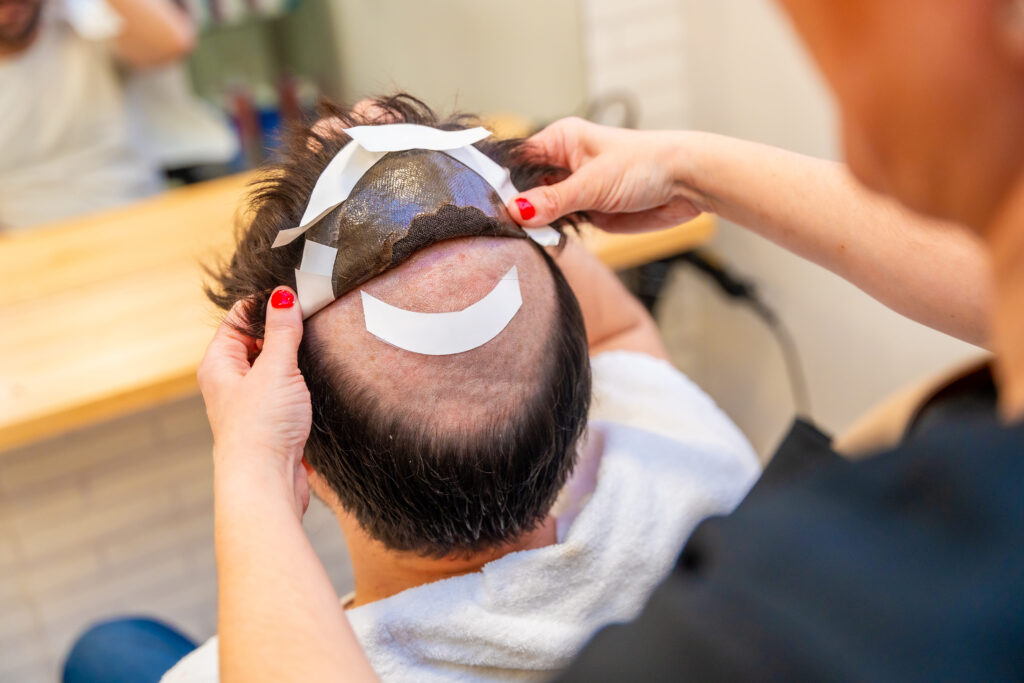- +97450262244
- info@hairreciveqatar.com

Hair loss doesn’t affect just your appearance—it can impact your identity, confidence, and daily life. With the rise in non-surgical solutions, hair fixing has emerged as a transformative alternative. But here’s the challenge: not all methods are created equal.
Whether you’re dealing with thinning, patchy baldness, or complete hair loss, choosing the right hair fixing type is crucial to achieving a natural, comfortable, and long-lasting result.
In this blog, we’ll break down the different types of hair fixing techniques available today, compare their pros and cons, and help you identify which one aligns best with your lifestyle, budget, and expectations.
Let’s explore the most widely used hair fixing techniques, including how they work, who they’re best suited for, and what to expect.
One of the most popular methods in salons today, tape hair fixing involves securing the hair patch to the scalp using double-sided adhesive tapes. It’s quick, painless, and effective for mild to moderate baldness.
Ideal For:
People with sensitive scalps
Short to medium-term wear
First-time users
Pros:
Quick application (under 1 hour)
Comfortable and lightweight
Easy to remove and replace
Affordable cost
Cons:
Requires re-taping every 10–15 days
Adhesive may weaken with sweat or oily scalps
Tip: Opt for ultra-thin medical-grade tapes for a secure, skin-safe bond. Check out options from brands like Walker Tape.
Glue-based hair fixing uses liquid adhesive to bond the hair patch directly to the scalp. This method provides a stronger hold and is suitable for longer wear durations.
Ideal For:
Active individuals
People with larger bald patches
Users seeking up to 3–4 weeks of continuous wear
Pros:
Durable and weather-resistant
Gives a natural hairline appearance
Ideal for styling and sports
Cons:
Requires professional application
Scalp must be cleaned properly before reapplication
Risk of skin irritation if glue is not high-quality
Pro Tip: Use a scalp protector and patch test the adhesive to avoid reactions. Brands like Ghost Bond are widely used by professionals.
This non-permanent technique uses metal or plastic clips to secure the hair system into existing hair. It’s ideal for those who want flexibility or temporary solutions.
Ideal For:
People with some natural hair remaining
Occasional use (e.g., events or public appearances)
Elderly clients or those averse to adhesives
Pros:
No chemicals or adhesives used
Completely reversible
Can be attached and removed daily
Cons:
Not suitable for fully bald individuals
Clips can tug on hair and cause discomfort
Best For: Anyone seeking a quick-fix, low-commitment solution that doesn’t involve skin contact or maintenance stress.
This involves weaving the hair system into your existing hair using braids or a mesh cap. The patch is sewn into the structure, offering a secure and semi-permanent solution.
Ideal For:
People with moderate hair volume on the crown
Those seeking a long-lasting, natural look
Women with thinning hair
Pros:
Lasts up to 4–6 weeks
No adhesive involved
Breathable and durable
Cons:
Time-consuming application (2–3 hours)
Requires regular tightening
Not suitable for total baldness
Insider Note: Ensure the base is made of lightweight, breathable material to prevent itchiness and scalp irritation.
Popular for those looking to add volume rather than cover baldness, this method uses tiny beads to attach strands of hair to your existing locks.
Ideal For:
Women with thinning or fine hair
People wanting volume or partial extensions
Pros:
Adds density without glue or heat
Reusable and low-damage
Natural movement
Cons:
Requires sufficient existing hair
Beads may slip without proper care
This is not a full hair patch method, but for hair enhancement, it’s a trendy, effective solution.
The base of the hair patch is made with silicone or PU material that mimics scalp skin. It adheres with glue or tape and gives the most natural appearance and realistic hairline.
Ideal For:
Professionals on camera or under lights
Clients demanding the most natural look
Pros:
Undetectable finish
Soft, flexible material
Great for HD visuals
Cons:
Slightly higher cost
Requires regular maintenance due to sweat buildup
Hair fixing is no longer a one-size-fits-all solution. From easy tape methods to premium silicone systems, there’s a hair fixing type for every lifestyle, need, and budget.
Understanding your hair loss stage, comfort level, and long-term goals will help you make the best decision—one that brings back not just your hair, but your confidence and identity
Message us now